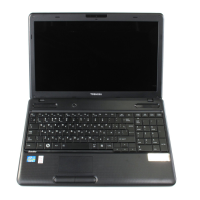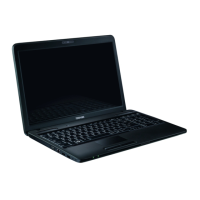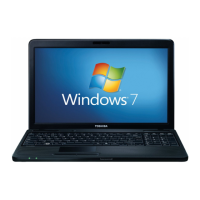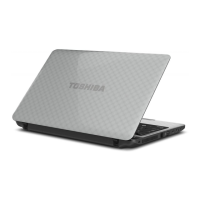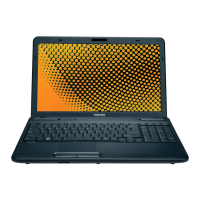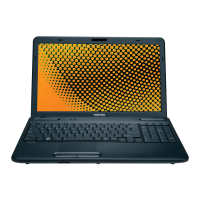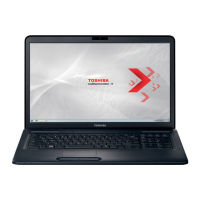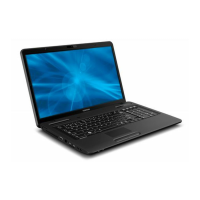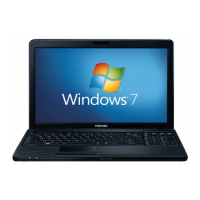
Do you have a question about the Toshiba C660D and is the answer not in the manual?
| Storage | 320GB HDD |
|---|---|
| Graphics | AMD Radeon HD 6310 |
| Operating System | Windows 7 Home Premium |
| Battery | 6-cell Lithium-ion |
| Optical Drive | DVD SuperMulti Drive |
| RAM | DDR3 |
| Display | 15.6-inch HD (1366 x 768) |
Lists items to check after unpacking the computer to ensure all necessary components are present.
Instructions on how to connect the AC adapter for powering the computer and charging the battery.
Guidance on how to safely open the computer's display panel to a suitable viewing angle.
Steps to power on the computer for the first time and initial startup procedures.
Procedures for properly shutting down, sleeping, or hibernating the computer.
Instructions for using the computer's Sleep Mode to pause operation and save power.
How to use the computer's Hibernation Mode to save the system state to disk.
Procedures for accessing system recovery and restoring factory-installed software.
Identifies external components on the front of the computer when the display is closed.
Identifies ports, vents, and other components located on the left side of the computer.
Identifies ports and other components located on the right side of the computer.
Identifies components and access panels located on the bottom of the computer.
Identifies external components on the front of the computer when the display is open.
Explains the function and meaning of various system status indicators (LEDs).
Details the computer's DVD Super Multi drive and supported media types.
Information about the AC adapter, its specifications, and connection procedures.
Describes the computer's core hardware components such as CPU, memory, and power.
Information on network connectivity features like LAN, Bluetooth, and Wireless LAN.
Highlights unique or advanced features that enhance computer usability.
Describes pre-installed software utilities and provides instructions on how to start them.
Lists optional devices and accessories that can expand the computer's capabilities.
Instructions on how to use the Touch Pad for cursor control and interaction.
Usage details and features of the built-in Web Camera for video capture.
How to use the facial recognition software for secure and convenient login.
Guidance on using the optical drive to write data to CDs and DVDs.
Explanation of audio control functions, including volume adjustment and system sounds.
Information on wireless communication functions like LAN, Bluetooth, and their operation.
Describes the standard keys for typing letters, numbers, and punctuation.
Details how to use the FN key with other keys for accessing special functions.
Explains how to use hot keys (FN + Function key) to enable or disable features.
Explains how different power conditions affect computer operation and indicators.
How to check battery and AC adapter status using system indicators.
Information on battery types, usage, charging methods, and handling precautions.
Procedures and important notices related to recharging the computer's battery.
Step-by-step instructions for removing and installing the battery pack.
How to set, change, or delete user and supervisor passwords for system security.
Steps required to log in to the computer using a set password.
Explains different power states: Shut Down, Sleep, and Hibernation Modes.
Instructions on how to launch the TOSHIBA HW Setup program for configuration.
Overview of the HW Setup window, its tabs, and available configuration options.
Settings for selecting the display used when the computer starts up.
How to set the priority order for booting the computer from various devices.
Configuration settings related to the keyboard, including Wake-up on Keyboard.
Settings for enabling or disabling the built-in LAN and Wake-up on LAN features.
Guidelines for identifying and resolving computer problems effectively.
Checklist for diagnosing common problems with computer hardware and peripherals.
Troubleshooting steps for issues related to computer power sources and battery.
Specific troubleshooting steps for battery-related issues, including charging problems.
Steps to resolve problems related to the hard disk drive, such as slow performance.
Troubleshooting steps for issues encountered with the optical disc drive.
Information on how to contact TOSHIBA for technical assistance and support.
Specifies the acceptable ambient temperature and relative humidity ranges for operation.
Details the AC voltage and frequency requirements for the AC adapter.
Explains the function of the display controller in interpreting commands for the screen.
How to configure video mode settings via the Screen Resolution dialog.
Information on Wireless LAN standards (IEEE 802.11) and Wi-Fi certification.
Details on Bluetooth standards (Ver. 3.0+HS, 2.1+EDR) and product interoperability.
Important cautions regarding the safe use of wireless devices and potential interference.
Details length, wire size, current, and voltage ratings for power cords.
Lists various certification agencies for power cords in different countries.
Legal footnotes regarding CPU performance variations under different conditions.
Legal footnotes concerning system memory usage, graphics allocation, and capacity.
Legal footnotes related to battery life variations and performance.
Legal footnotes defining HDD capacity measurements and variations.
Legal footnotes regarding Wireless LAN transmission speed and environmental factors.
Procedures for reporting a stolen computer to TOSHIBA for tracking.
